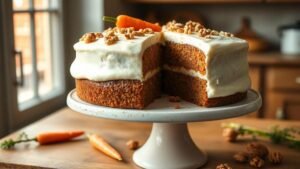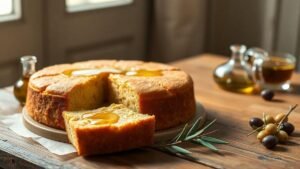Bake Gluten-Free with Confidence: Soft, Moist, Flavorful Cakes (No Gluten, No Compromise)
I know how confusing gluten-free baking can feel. I want you to bake with confidence. In this guide I share my best gluten-free cake secrets so you can make a cake that is soft, moist, flavorful, and inclusive. Learn how the right flour blend, added moisture, and bold flavors recreate that familiar cake texture. Includes a simple recipe for an easy cake, practical tips and troubleshooting notes, flavor ideas, and safe frosting and storage notes.
- Use a balanced blend of gluten-free flours and starches for a soft crumb
- Add extra moisture so the cake stays tender
- Boost flavor so it tastes like a regular cake
- Always check labels to avoid hidden gluten
- Frost and store like a regular cake for a happy crowd
How to Make a Gluten-Free Cake That Tastes Great: Soft, Flavorful, Inclusive
Gluten-free baking can feel like learning a new skill, but with a good flour mix, proper hydration, and a few tricks you can bake cakes that are soft, moist, and full of flavor. Below is a practical roadmap.
What Is a Gluten-Free Cake?
A gluten-free cake avoids wheat, barley, and rye — meaning no gluten protein. You replace gluten’s stretch with a mix of flours, starches, and binders (like xanthan gum or psyllium), plus extra moisture and gentle handling.
What it avoids | What it uses
- –|—
Wheat, barley, rye | Rice flour, almond flour, oat flour (certified GF)
Gluten protein | Starches (tapioca, potato, cornstarch)
Traditional gluten structure | Gums (
xanthan or psyllium) or extra eggs
Always read labels. Some ingredients hide gluten — check every package.
Best Gluten-Free Flours for Cake
Mixing flours and starches is the key to recreating a tender, familiar crumb.
Flour / Starch | Texture it gives | How I use it
- –|—:|—
White rice flour | Light, neutral | Base of many blends
Almond flour | Rich, tender | Use up to 25–30% for flavor
Oat flour (certified GF) | Soft crumb | Adds moisture and nuttiness — see my notes on using oat flour: baking with oat flour
Sorghum | Mild, slightly grainy | Small additions for whole-grain taste
Buckwheat | Earthy, strong | Use sparingly
Tapioca starch | Chewy, light | Adds spring and moisture
Potato starch | Soft crumb | Enhances tenderness
Cornstarch | Fine, silky | For lightness
Xanthan gum / psyllium | Binds and holds | Small amounts for structure; for allergy-friendly binder options see alternative binding methods
Tip: A balanced mix of flours starches gives a cake closest to wheat-based texture.
Gluten-Free Vanilla Cake Recipe
This is my go-to gluten-free cake — simple, reliable, and crowd-pleasing.
Ingredients
Ingredient | Amount | Note
- –|—:|—
Gluten-free flour blend (see below) | 2 cups (240 g) | See blend
Sugar | 1 cup (200 g) | Granulated
Baking powder | 2 tsp | Make sure it’s gluten-free
Salt | 1/2 tsp |
Eggs | 3 large | Room temp
Milk | 3/4 cup (180 ml) | Dairy or plant milk
Melted butter or oil | 1/2 cup (120 ml) | Oil keeps cakes moister
Vanilla extract | 2 tsp |
Xanthan gum | 1 tsp | If your blend lacks a binder
My Simple Flour Blend (for 2 cups)
Component | Amount
- –|—:
White rice flour | 1 cup
Tapioca starch | 1/2 cup
Potato starch | 1/4 cup
Almond flour | 1/4 cup
Instructions
Step | What to do
- –:|—
1 | Preheat oven to
350°F (175°C). Grease a 9-inch pan.
2 | Whisk dry ingredients: flour blend, sugar, baking powder, salt, xanthan gum (if using).
3 | Whisk wet ingredients: eggs, milk, oil, vanilla.
4 | Fold wet into dry. Stir until smooth — don’t overbeat.
5 | Pour into pan and tap to release air bubbles.
6 | Bake 25–35 minutes. Toothpick should come out clean.
7 | Cool 10 minutes in pan, then transfer to a rack. Frost when completely cool.
Result: A moist, soft, lightly sweet cake. Often people can’t tell it’s gluten-free. Still — double-check store-bought items for hidden gluten.
If you prefer fewer ingredients or a quicker batter, I also keep a very simple five-ingredient approach handy: a straightforward five-ingredient cake that’s easy to adapt.
Tips for Better Gluten-Free Cakes
These practical tips are what I learned the hard way:
Tip | Why it helps
- –|—
Use a mix of flours and starches | Keeps crumb light and soft
Add a binder (
xanthan or psyllium) | Gives structure so cake doesn’t crumble
Don’t overmix | Keeps cake tender
Add extra moisture (oil, applesauce, sour cream, or yogurt) | Gluten-free flours can dry out — for yogurt-based moisture ideas see using yogurt for a soft cake
Rest batter 15–30 minutes | Allows flours to hydrate for better baking
Lower oven temp 10–15°F | Prevents overbrowning while the interior finishes
Use room-temp ingredients | Mixes more evenly
Small swaps matter: I once replaced oil with applesauce for a lighter crumb — it worked beautifully.
Flavor Ideas for Gluten-Free Cakes
Flavor | How to add it
- –|—
Lemon | Zest 2 tbsp juice in batter
Chocolate | Replace 1/2 cup flour with cocoa powder add extra moisture
Almond | 1/2 tsp almond extract slightly more almond flour
Carrot | Fold in grated carrot warm spices
Cinnamon spice | 1–2 tsp cinnamon a pinch of nutmeg
Coffee | Add 2 tbsp strong brewed coffee to the batter
Want to add fruit without sogginess? See my guide on the best ways to add fruit to cake, or explore creative finishes in using fresh fruit as a natural topping. Taste as you go — add small amounts, then adjust.
Frosting Options (All Gluten-Free)
Most classic frostings are naturally gluten-free; still check labels on extract and sprinkles.
Frosting | Key ingredients | Texture
- –|—|—
Buttercream | Butter powdered sugar milk | Smooth, sweet
Cream cheese | Cream cheese butter sugar | Tangy, creamy
Chocolate ganache | Chocolate cream | Silky, rich
Whipped cream | Heavy cream sugar | Light, airy
Swiss meringue | Egg whites sugar butter | Smooth, less sweet
If you prefer to skip frosting entirely, a well-flavored crumb can stand alone — see ideas for serving a cake that doesn’t need frosting: serve-ready cakes without icing.
Frosting is where I have fun — pipe imperfectly and enjoy the process.
Storage
How you store a gluten-free cake depends on frosting and time.
Place | How long | Tip
- –|—:|—
Room temp (covered) | 1–2 days | Keep away from heat
Fridge (covered) | 3–5 days | Best for cream or cheese frostings
Freezer (wrap well) | 2–3 months | Thaw in fridge overnight
I slice and wrap pieces for quick snacks. Freezing works great.
No Gluten, No Compromise
I bake to include people at my table. A little care — the right flour blend, added moisture, and a reliable binder — will give you a cake that’s truly soft, moist, and full of flavor. Mistakes happen, but they’re useful teachers.
Want more recipes, experiments, and hard-won tips? Explore my full collection of gluten-free cake recipes that actually taste good or read my broader guide on how to make a gluten-free cake that still tastes great.
Leave a Comment / Cancel Reply
I welcome your thoughts. Leave a comment and I’ll read and reply. I save your info to make commenting easier next time.
Field | Information
- –|—
Comment | Required
Name | Required
Email | Required
Website | Optional
Save my info | Checkbox
Your email address will not be published. Required fields are marked.
Recent Posts
Title | Note
- –|—
I Steamed My Way To Cake | My steamed cake experiment — notes and method:
stovetop and steaming methods
I Replaced Oil with Applesauce | Lighter cakes with a fruit swap
I Baked a Three-Ingredient Sponge Cake | Simple and fast
I Made Cake in a Blender Bottle | Quick, small-batch idea
Conclusion
With a simple roadmap — use a balanced gluten-free flour blend, add extra moisture, include a reliable binder, and handle the batter gently — you can bake cakes that are soft, moist, and full of flavor. Check labels, let the batter rest, avoid overmixing, and adjust oven temp slightly. Small habits make big differences. If you take one thing away: a little care and the right mix will bring everyone to the table.
Frequently Asked Questions
Q: How do I make a gluten-free cake soft and moist?
A: Use a blend of flours and starches, add extra moisture (yogurt, oil, applesauce, or sour cream), don’t overmix or overbake, and add a small amount of xanthan or psyllium for structure.
Q: Which flours work best for cake?
A: Use a ready-made 1:1 gluten-free flour, or mix rice flour with tapioca or potato starch. Add a bit of almond or oat flour for flavor — see practical guidance on using oat flour in cakes.
Q: How do I avoid hidden gluten in ingredients?
A: Always read labels. Look for gluten-free or certification. Avoid malt, barley, and unlabelled oats. Watch extracts, sprinkles, baking powder, and processed ingredients for cross-contamination.
Q: Are frostings and fillings usually gluten-free?
A: Most buttercreams, cream cheeses, and ganaches are gluten-free. Check flavorings and packaged toppings. When in doubt, make a simple homemade frosting or choose a cake that doesn’t require icing: ideas for unfrosted cakes.
Q: How should I store a gluten-free cake to keep it fresh?
A: Cover and keep at room temp for 1–2 days. Refrigerate up to 4–5 days for cream or cheese frostings. Freeze slices for longer storage and thaw in the fridge before serving.






